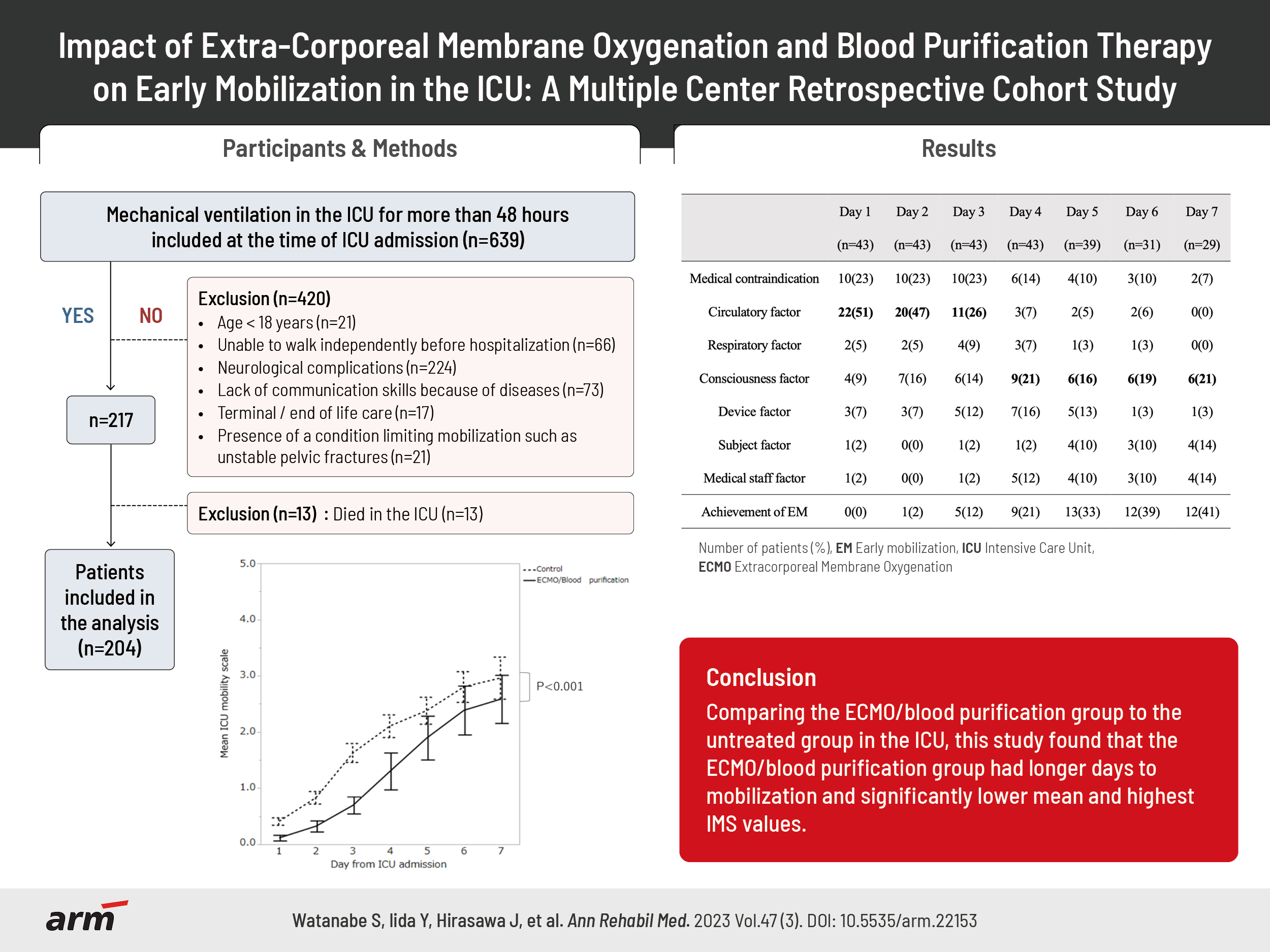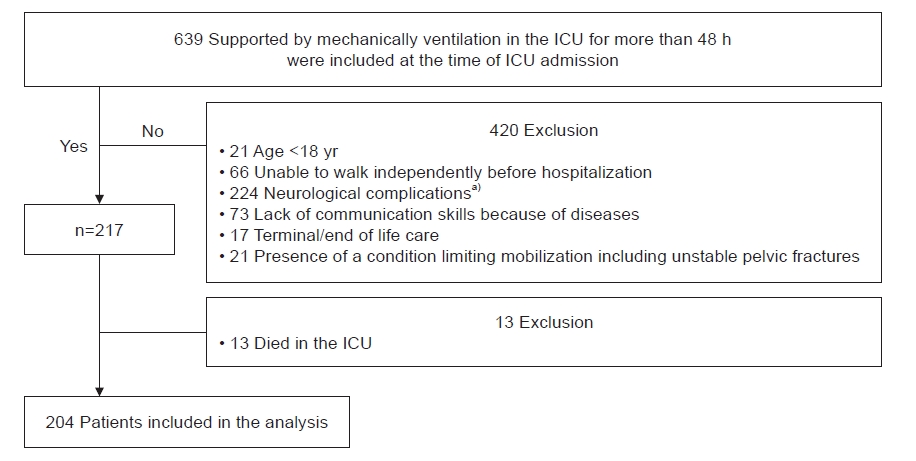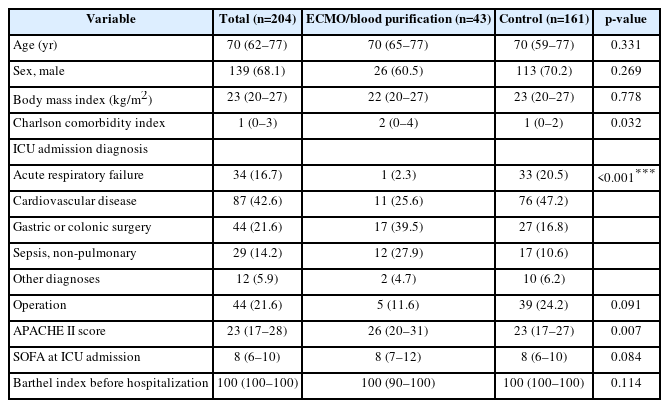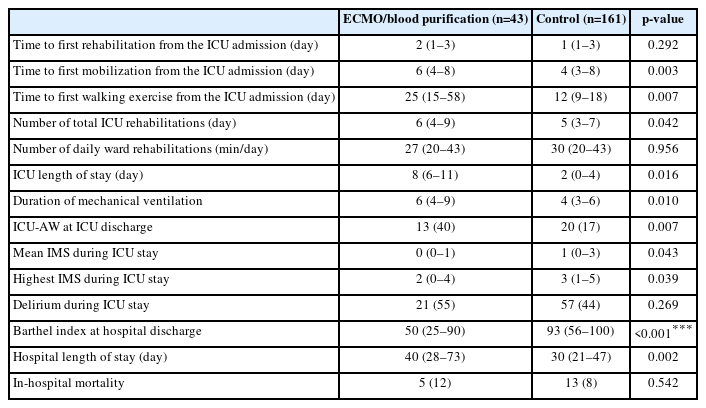Impact of Extra-Corporeal Membrane Oxygenation and Blood Purification Therapy on Early Mobilization in the Intensive Care Unit: Retrospective Cohort Study
Article information
Abstract
Objective
To investigate the effect on early mobilization in patients undergoing extra-corporeal membrane oxygenation (ECMO) and acute blood purification therapy in the intensive care unit (ICU).
Methods
We conducted this multicenter retrospective cohort study by collecting data from six ICUs in Japan. Consecutive patients who were admitted to the ICU, aged ≥18 years, and received mechanical ventilation for >48 hours were eligible. The analyzed were divided into two groups: ECMO/blood purification or control group. Clinical outcomes; time to first mobilization, number of total ICU rehabilitations, mean and highest ICU mobility scale (IMS); and daily barrier changes were also investigated.
Results
A total of 204 patients were included in the analysis, 43 in the ECMO/blood purification group and 161 in the control group. In comparison of clinical outcome, the ECMO/blood purification group had a significantly longer time to first mobilization: ECMO/blood purification group 6 vs. control group 4 (p=0.003), higher number of total ICU rehabilitations: 6 vs. 5 (p=0.042), lower mean: 0 vs. 1 (p=0.043) and highest IMS: 2 vs. 3 (p=0.039) during ICU stay. Circulatory factor were most frequently described as barriers to early mobilization on days 1 (51%), 2 (47%), and 3 (26%). On days 4 to 7, the most frequently described barrier was consciousness factors (21%, 16%, 19%, and 21%, respectively)
Conclusion
The results of this study comparing the ECMO/blood purification group and the untreated group in the ICU showed that the ECMO/blood purification group had significantly longer days to mobilization and significantly lower mean and highest IMS.
INTRODUCTION
In recent years, advances in life-saving technology for critically ill patients in the intensive care unit (ICU) have significantly improved survival rates. However, even if they survive, 25%–70% of them in the ICU have severe disease, and invasive treatment and inactivity cause serious physical impairments such as ICU-acquired weakness (ICU-AW) and decreased activities of daily living (ADL), leading to increased medical costs and worsen life prognosis [1].
In Japan, in the 2022 medical fee revision, for patients who require acute blood purification or extra-corporeal membrane oxygenation (ECMO), the upper limit of days for calculation of special ICU management fee extended from 14 to 25 days. It is stated as a calculation condition that a sufficient system be developed for efforts aimed at early recovery of patients, but the maximum number of days for ICU rehabilitation medical treatment system has not been changed from 14 days [2].
As a preventive measure against physical dysfunction after leaving the ICU, early mobilization starting within one week of admission to the ICU is attracting international attention. Previous studies have reported the effects of early mobilization to prevent delirium, shorten the duration of mechanical ventilation and length of ICU stay, and improve physical function [3-6]. In Japan, early mobilization rehabilitation additional calculation has been allowed since 2019, and the number of implementation cases is increasing, mainly for nurses and physical therapists [7]. However, while many benefits are expected for early mobilization of critically ill patients, it has been reported that there are many barriers to actual implementation [8]. The main obstacles are limited activities due to the use of equipment such as ECMO and acute blood purification, disturbance of consciousness due to sedation, and lack of manpower for team staff. Therefore, even if the patient’s general condition improves, there are cases in which the patient’s mobilization does not progress due to general muscle weakness or delirium.
The purpose of this study was to investigate the effect on early mobilization in patients undergoing ECMO and acute blood purification therapy in the ICU. This study focused on patients who underwent ECMO and acute blood purification in the ICU and examined how much it affected the attainable level of mobilization compared with those who did not.
METHODS
Study design, setting, and patients
The medical records of patients admitted to the ICU of one of six Japanese tertiary hospitals between April 2019 and March 2020 were retrospectively reviewed. This multicenter retrospective cohort study was conducted at the Nagoya Medical Center and by that of five other participating hospitals. This study was approved by the Ethics Committee of Nagoya Medical Center (approval number: 2021-012). It was conducted in accordance with Helsinki Declaration and the need for informed consent, according to national legislation, was waived by the IRB listed above because this was a retrospective cohort study. All patients admitted to the ICU of one of six Japanese tertiary hospitals between from April 2019 to March 2020 were screened. Patients were excluded if they were weaning mechanical ventilation for within 48 hours, were less than 18 years old, were unable to walk independently before hospitalization, were neurologically impaired, had difficulty communicating, were considered terminal; all other patients were included. The analyzed were divided into two groups: the ECMO/blood purification group that underwent ECMO or blood purification therapy upon admission to the ICU, or control group that did not. The definition of blood purification therapy in this study was the use of all renal support therapy administered during ICU admission, including continuous and intermittent hemofiltration dialysis, excluding chronic maintenance dialysis and peritoneal dialysis [9].
Data collection
Data on the participant’s age, sex, body mass index, Charlson comorbidity index, ICU admission diagnosis, operation, Acute Physiology and Chronic Health Evaluation II (APACHE II) score, Sequential Organ Failure Assessment score, and Barthel index before hospitalization, were recorded as basic characteristics.
Outcomes
The clinical outcomes of this study were time to first rehabilitation and first mobilization and first walking exercise from the ICU admission, number of total ICU rehabilitations, number of daily ward rehabilitations, ICU length of stay, duration of mechanical ventilation, ICU-AW at ICU discharge, mean and highest ICU mobility scale (IMS) during ICU stay, delirium during ICU stay, Barthel index at hospital discharge, hospital length of stay, and in-hospital mortality. The IMS is a sensitive 11-point ordinal scale, with scores ranging from 0 (no mobilization) to 10 (independent ambulation) [10]. ICU-AW was evaluated using Medical Research Council score by the responsible physical therapist, and a value of less than 48 was defined as having developed an ICU-AW [11]. For the assessment of delirium, either the delirium screening tool of the Intensive Care Delirium Screening Checklist was used [12].
Subanalysis
To examine factors for delayed mobilization in ECMO/blood purification therapy or control group, we investigated predefined barriers described in previous studies for 7 days from ICU admission. These included consciousness, subjective symptoms, and respiratory, circulatory, device, subject, and medical staff factors [8]. If several barriers were identified in one session, only the primary reason was recorded, and not the individual components of categories. During each rehabilitation session, a physical therapist in the ICU determined the primary barrier preventing mobilization by the end of the session according to the algorithm shown in Fig. 1. The rehabilitation intensity higher than the level of sitting at the bedside was defined as “mobilization” [8].
Data analysis
Results are expressed as the median and quartiles for quantitative data and as number and percent for categorical data. Chi-square test or Fisher’s exact test was used to assess the associations between intervention groups and categorical variables. The Mann–Whitney U-test was used for intergroup comparison of continuous variables. In addition, a one-way analysis of variance was used to compare the mean IMS from ICU admission to day 7 in the ECMO/blood purification group and the control group. We also used a chi-square test to compare the rate of each barrier from ICU admission to day 7 in the ECMO/blood purification group and the control group. All analyses were performed using JMP software (version 13.0; SAS Institute Inc., Cary, NC, USA). Statistical tests were two-sided, and statistical significance was defined as p<0.05.
RESULTS
During the study period from April 2019 to March 2020, 639 patients were screened, and 206 patients were enrolled in this study (Fig. 2). In this study, 43 patients were divided into the ECMO/blood purification group (ECMO, 15; continuous hemodiafiltration, 34; intermittent hemodialysis, 20; direct hemoperfusion with polymyxin B immobilized fiber, 20) and 161 control groups.
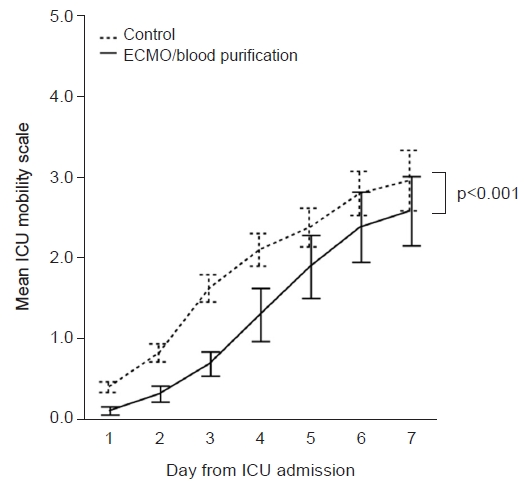
Comparison of mean intensive care unit (ICU) mobility scale from day 1 to 7 of ICU admission. The one-way analysis of variance was used to compare the mean ICU mobility scale (IMS) from ICU admission to day 7 in the extra-corporeal membrane oxygenation (ECMO)/blood purification group and the control group. Comparison of mean IMS from ICU admission to day 7 was significantly lower in the ECMO/blood purification group compared with the control group (p<0.001). Measured by IMS, 0=no activity; 1=exercises in bed; 2=passively moved to the chair; 3=sitting on the edge of the bed; 4=standing; 5=transferring from bed to chair through standing; 6=marching on the spot; 7=walking with assistance of two people; 8=walking with assistance of one person; 9=walking independence with assistive device; and 10=walking independently.
The baseline characteristics and clinical outcome during hospitalization of the study population are shown in Tables 1 and 2. In comparison of baseline data, the ECMO/blood purification group had a significantly higher Charlson comorbidity index (p=0.032) and APACHE II score (p=0.007; Table 1).
A comparison of ICU admission diagnoses revealed that the ECMO/blood purification group had higher rates of gastric or colonic surgery and sepsis than the control group. In comparison of clinical outcome, the ECMO/blood purification group had a significantly longer time to first mobilization: ECMO/blood purification group 6 (4–8) vs. control group 4 (3–8) (p=0.003) and first walking exercise: 25 (15–58) vs. 12 (9–18) (p=0.007), higher number of total ICU rehabilitations: 6 (4–9) vs. 5 (3–7) (p=0.042), longer ICU length of stay: 8 (6–11) vs. 2 (0–4) (p=0.016) and duration of mechanical ventilation: 6 (4–9) vs. 4 (3–6) (p=0.010), higher incidence of ICU-AW: 13 (40%) vs. 20 (17%) (p=0.007), lower mean: 0 (0–1) vs. 1 (0–3) (p=0.043) and highest IMS: 2 (0–4) vs. 3 (1–5) (p=0.039) during ICU stay, lower Barthel index at hospital discharge: 50 (25–90) vs. 93 (56–100) (p<0.001), longer hospital length of stay: 40 (28–73) vs. 30 (21–47) (p=0.002; Table 2).
Comparison of mean IMS from ICU admission to day 7 was significantly lower in the ECMO/blood purification group compared with the control group (p<0.001; Fig. 3).
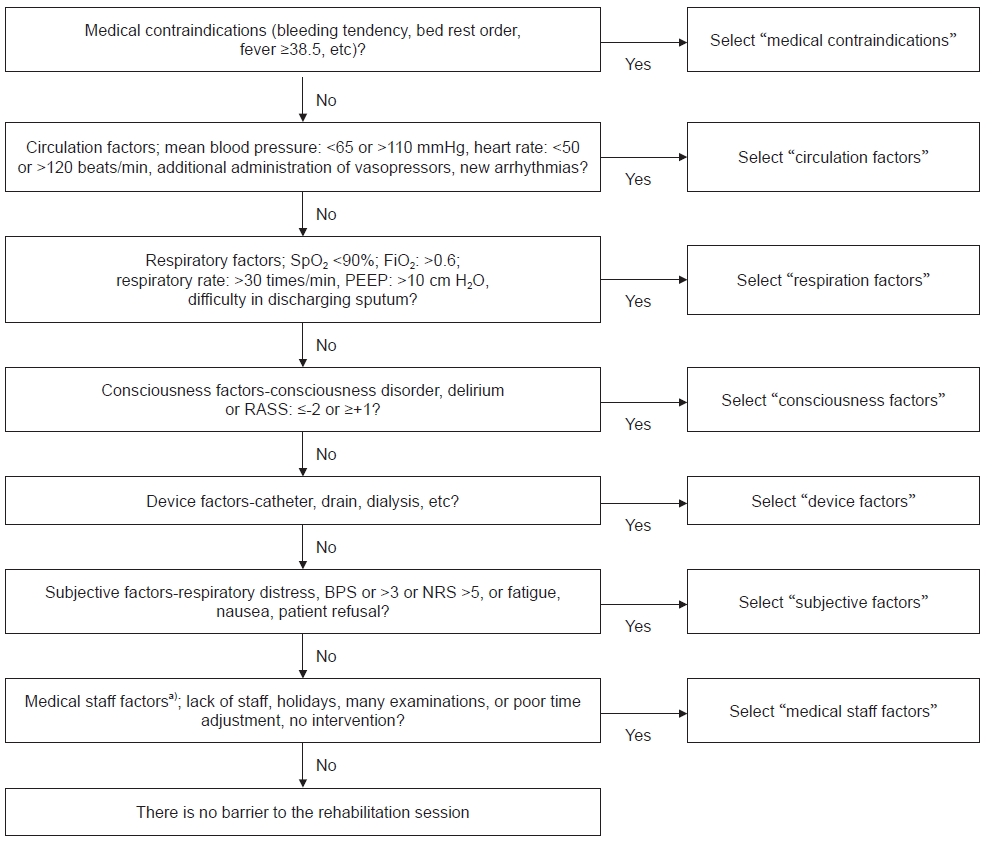
Algorithm to determine the primary barrier preventing mobilization. The barrier to mobilization was determined by the intensivist in charge of the patient following this algorithm. In every rehabilitation session, only one selected barrier was recorded in the medical record. SpO2, oxygen saturation of the peripheral artery; FiO2, fraction of inspiratory oxygen; PEEP, positive end-expiratory pressure; RASS, Richmond agitation sedation scale; BPS, behavioral pain scale; NRS, numerical rating scale.
Circulatory factor were most frequently described as barriers to early mobilization (EM) on days 1 (51%), 2 (47%), and 3 (26%). On days 4 to 7, the most frequently described barrier was consciousness factors (21%, 16%, 19%, and 21%, respectively; Table 3). Also device factor, subject factor, and medical staff factor also tended to increase from day 3 to day 7. Medical factors were the most frequently described as barriers to EM in the control group from days 1 to 7 (Table 4). Medical contraindication was the most frequently described as barriers to EM in the control group from days 1 to 7. In addition, compared to the ECMO/blood purification group, the control group tended to have lower device and conscious factors, and a higher achievement of mobilization. Comparing the rate of each barrier from ICU admission to day 7, there was a significant difference between two groups in consciousness factor (p=0.003) and device factor (p=0.037), achieved rate of EM (p=0.041).
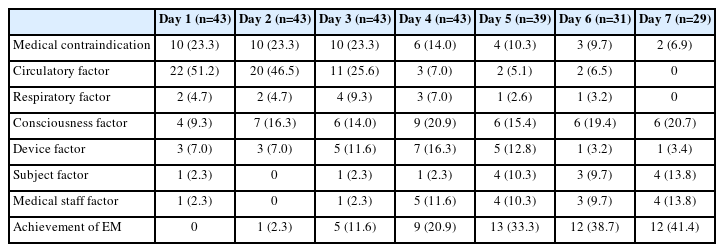
Primary barriers preventing the achievement of early mobilization in the extra-corporeal membrane oxygenation/blood purification group
DISCUSSION
In previous study on critically ill patients in the ICU, factors such as circulation factors, awareness factors such as sedation, activity restrictions by devices, and staff shortages have been reported as barriers to getting out of bed [8]. However, there are few papers that consider the intervention time of rehabilitation and barriers to mobilization, such as how long it takes for ECMO/blood purification therapy patients to mobility out of bed. In this study, we investigated the number of days required for ambulation and the duration of rehabilitation in ECMO/blood purification therapy patients.
In previous studies on early rehabilitation, there have been some reports that examined single factors such as the start time and exercise intensity [13,14]. Additionally, in a previous study that focused on the number of days until mobilization in ICU patients, the percentage of independent walking at discharge was significantly higher in the group that achieved mobilization within 7 days in the ICU compared to the group that did not. In Japan, early mobilization/rehabilitation additions have been calculated since 2019, but the target number of days until mobilization is being explored at each hospital. In this study, the number of days until mobilization was significantly longer in the ECMO/blood purification group, and the number of ICU rehabilitation sessions was also significantly higher in the ECMO/blood purification group. In blood purification therapy, it is important for the staff to coordinate the environment in order to provide safe medical care, such as crisis management, physical restraints to ensure rest, posture management, mental care, and rehabilitation in cooperation with various occupations [15]. Previous studies in critically ill patients have reported an association between dose of rehabilitation and ADL dependence, assessed based on rehabilitation intensity, time and frequency [13,16]. The rehabilitation strategy for critically ill patients is not only the maximum rehabilitation intensity achieved, but also the time and frequency are important factors. It is speculated that in rehabilitation to ECMO/blood purification therapy, the number of rehabilitation sessions was increased to cope with the decrease in average IMS and highest IMS. Determining the optimal rehabilitation intensity, time and frequency, tailored to the patient’s severity and device conditions, should be the focus of future research [17].
Regarding the increase in ICU days associated with ECMO/blood purification therapy, in a report based on data processing center, the mean ICU length of stay was the longest in the group of patients undergoing blood purification+mechanical ventilation [16]. Similarly, in this study, the length of ICU stay in the blood purification group was significantly longer than that in the control group [18]. In Japan, based on the medical fee revision in 2018, early mobilization and rehabilitation premiums were introduced in the ICUs. In addition, from 2021, “calculation of the specified ICU management fee in excess of the maximum number of 14 days” is permitted for cases requiring long-term ICU management. However, under the current medical fee system, the maximum number of days for calculation is extended to 25 days for patients undergoing ECMO/blood purification therapy, but the maximum number of days for early mobility rehabilitation is 14 days. Risk factors for the development of physical dysfunction in critically ill patients are multifactorial, including age, delirium, occurrence of ICU-AW, and immobility [3,6,7]. Of these, supine rest is an easily ameliorated risk factor. Given these proposed mechanisms, rehabilitation time for patients staying longer than 14 days was considered inadequate and a risk factor for physical dysfunction.
Regarding barriers to achieving of mobilization in the ECMO/blood purification therapy group, circulatory factor were the most common on days 1 to 3, but consciousness factor were the most common on days 4 to 7. In addition, device factors, subjective symptom, and medical staff factors increased from the 4th day. In a previous study examining barriers to mobilization in the ICU, device factors were significantly associated with achieving mobilization [19]. Furthermore, achievement of mobilization was associated with independent ADLs at discharge [19]. Barriers to achieving mobilization may be an important parameter for achieving ADL independence at discharge. In this study as well, the ECMO/blood purification group had a significantly lower achieving of mobilization than the control group, and significantly higher for device factors. Furthermore, when primary barriers were determined based on the algorithm shown in Fig. 1, there was a significant difference in the consciousness factor among the top factors between the two groups. The consciousness factor in the ECMO/blood purification therapy group appeared as the major barrier from days 4 to 7. The consciousness factor, similar to previous studies showing that deep sedation is a barrier to mobilization [20], it could have impeded EM of ECMO/blood purification therapy groups. Pain agitation and delirium guidelines recommend routine use of sedation protocols intended for light sedation [21]. However, no studies have examined whether an appropriate sedation protocol promotes EM, and its effects remain unclear. The impact of initiating routine use of sedation protocols in the ICU on EM needs further study. However, previous studies have reported that these factors are barriers that can be dealt with by interprofessional collaboration on the part of medical personnel and an increase in intervention time [8]. It was suggested that it is necessary to promote multidisciplinary collaboration after ensuring sufficient mobilization intervention time and frequency.
This study contains several limitations and the interpretation of the results should be interpreted with caution. This study is a retrospective study by multicenter study, and the survey period and the number of samples are limited. In this study, the number of patients was small, and there were many patients who used both ECMO and other blood purification therapies, so it was not possible to divide them into groups and analyze them. The severity of the patient may differ depending on the details of each device for ECMO and blood purification therapy, and it is necessary to increase the number of cases and examine it in the future. Furthermore, in this study, the number of days until mobilization was evaluated, but the evaluation of activities outside the rehabilitation period, such as activities by the patients themselves, was not sufficiently verified. Due to the nature of this retrospective cohort study, it is not possible to prove a causal relationship between ECMO and blood purification therapy and the number of days until mobilization. Randomized studies based on higher evidence, however, are considered very difficult to implement due to ethical considerations for non-interventional groups. Therefore, we cannot conduct a randomized study at this time, and we judge that a cohort study is the best possible study design. In the future, it is necessary to increase the number of cases and use a physical activity meter to verify the results.
In conclusion, the results of this study comparing the ECMO/blood purification group and the untreated group in the ICU showed that the ECMO/blood purification group had significantly longer days to mobilization and significantly lower mean and highest IMS.
In ECMO/blood purification therapy patients, multiple occupations require gracious rehabilitation to remove barriers to mobilization, and the current upper limit of 14 days may not be sufficient.
Notes
No potential conflict of interest relevant to this article was reported.
None.
Acknowledgements
The authors would like to thank the study coordinators, Dr. Shuichi Suzuki, PT Kaito Kochi, PT Keisuke Mizutani, Ns Ono Mika, PT Yoshinori Naito, PT Shintaro Yamamoto, PT Takehisa Ito, Yuji Mori, PT Naoki Takeshita, PT Yusuke Nagae, and PT Yuki Ito. The authors would also like to thank the entire ICU staff at all the participating hospitals. The authors thank Akiko Kada, a biostatistician at Nagoya Medical Center, for providing assistance in reviewing this manuscript.
Notes
Conceptualization: Watanabe S. Methodology: Watanabe S, Iida Y. Formal analysis: Watanabe S. Project administration: Iida Y, Morita Y. Visualization: Watanabe S. Writing – original draft: Watanabe S, Iida Y, Hirasawa J. Writing – review and editing: Naito Y, Mizutani M, Uemura A, Nishimura S, Suzuki K. Approval of final manuscript: all authors.

